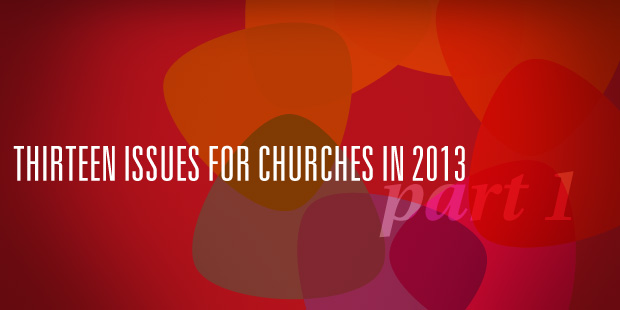
Thirteen Issues for Churches in 2013, Part One
As the new year unfolds, it is always a healthy exercise to look ahead to key opportunities and key challenges. Certainly such an effort is in order for congregations in North America. I plan to look at thirteen of those issues in this blog and my blog on Wednesday.
This extrapolation is not an exercise in keen foresight or extraordinary mental acumen. I am simply looking at current issues that seem to be gaining momentum. These issues will present themselves unevenly to different churches. But I foresee that tens of thousands of American congregations will be impacted by each of them.
I am grateful to Sam Rainer for his recent post, “Looking Ahead to 2013: What Should the Church Expect.” Many of his seminal ideas are captured in these articles. Though I list the issues in numerical order, I am not attempting to assign any degree of importance of one over another.
- The impact of the “nones.” The 2012 study by Pew Research rightfully garnered much attention. The percentage of the adult U. S. population that claims no religious affiliation increased from 15 percent in 2007 to 20 percent in 2012. That is an amazing 33 percent increase in that one category in a relatively short period. One implication for local congregation is the decrease of marginal church attendees, often called “CEO” (Christmas Easter Only) Christians. There is no longer much societal pressure to attend church. Those on the margins are thus falling off completely. There will continue to be a financial impact since these infrequent attendees typically provided some level of giving to their churches.
- Migration back to small groups. For three decades, the key emphasis in American church life has been the corporate worship experience. Though that emphasis is not going away, there is an increasing emphasis on moving people to small groups of all kinds: Sunday schools; home groups; life groups; etc. There is an increasing awareness that those who are in groups have a higher level of commitment in almost all areas of church life. As the Sunday school movement swept the nation for a half-century through the 1970s, a similar groups movement is already underway and should gain even more momentum.
- Accelerated closing of churches. The institutional church stubbornly resists formal closing. Even if only six or seven people attend each week, those few fight for the survival of their church. Those who were attending these very small churches are either moving to the “nones” category, or they are moving to larger churches. The primary stalwarts to keep the doors open are members of the builder generation, those born before 1946. As that generation decreases at an increasing rate, more churches will close. Any guess to the number of closings in 2013 is speculation on my part. I wouldn’t be surprised, however, if the numbers reach the 8,000 to 10,000 level.
- More churches moving to multiple venues. Membership in Mensa is not a requisite to have an insight on this issue. Just from an anecdotal perspective, the number of congregations moving to multiple venues is staggering. Indeed that issue may be the single greatest distinguishing factor in growing churches. The variety of the venues is increasing as well. Some churches have different venues on the same campus. Others move to multiple campus models. Some have an onsite preacher/teacher; others offer video streaming. Some churches have venues on Sunday only. Other churches have venues up to seven days a week. In the 1960s American congregations moved to multiple worship services in sweeping numbers. That same trend in multiple venues is taking place today. It should accelerate.
- The growth of prayer emphases in local congregations. Though prayer is foundational in the life of New Testament congregations, it frankly has not garnered much attention in recent years in American churches. There was a subtle but noticeable shift in 2012. More and more church leaders and members realized that the power and strength of health in their congregations is not human-centered but God-dependent. I am reticent to predict a true prayer revival in our nation, but I am confident in saying that more local congregations will focus on prayer. It will be interesting to see how such an emphasis manifests itself in each local body.
- Fickle commitment. In his post, Sam Rainer noted an overall decline in institutional loyalty. It is certainly pervasive in many American congregations. Indeed, the culture of the vast majority of American churches has been one of low commitment. That lower level of commitment is evident, paradoxically, in even the more committed members. Those members who once were present “every time the doors were open” may now be present, for example, 75 percent of the time. It is likely that decreased frequency of active attendees may be the single largest contributor to church decline in the past five years.
Read Part Two tomorrow.
Read more from Thom here.

Tags: Leadership Engine, Planning, Thom Rainer













